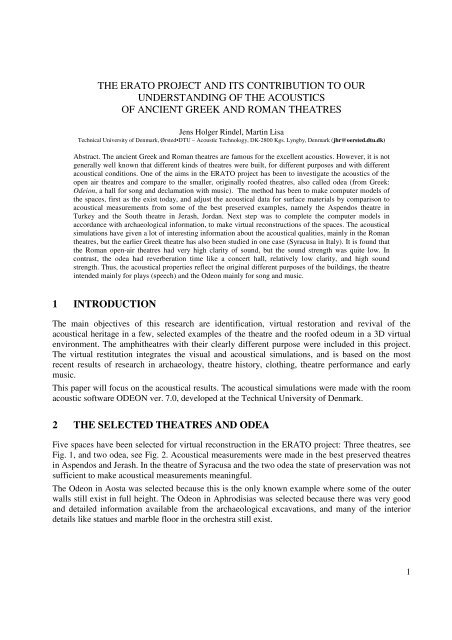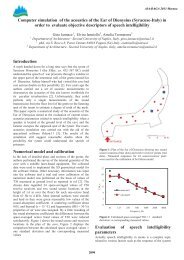ERATO Proceedings Istanbul 2006.pdf - Odeon
ERATO Proceedings Istanbul 2006.pdf - Odeon
ERATO Proceedings Istanbul 2006.pdf - Odeon
You also want an ePaper? Increase the reach of your titles
YUMPU automatically turns print PDFs into web optimized ePapers that Google loves.
THE <strong>ERATO</strong> PROJECT AND ITS CONTRIBUTION TO OUR<br />
UNDERSTANDING OF THE ACOUSTICS<br />
OF ANCIENT GREEK AND ROMAN THEATRES<br />
Jens Holger Rindel, Martin Lisa<br />
Technical University of Denmark, Ørsted•DTU – Acoustic Technology, DK-2800 Kgs. Lyngby, Denmark (jhr@oersted.dtu.dk)<br />
Abstract. The ancient Greek and Roman theatres are famous for the excellent acoustics. However, it is not<br />
generally well known that different kinds of theatres were built, for different purposes and with different<br />
acoustical conditions. One of the aims in the <strong>ERATO</strong> project has been to investigate the acoustics of the<br />
open air theatres and compare to the smaller, originally roofed theatres, also called odea (from Greek:<br />
Odeion, a hall for song and declamation with music). The method has been to make computer models of<br />
the spaces, first as the exist today, and adjust the acoustical data for surface materials by comparison to<br />
acoustical measurements from some of the best preserved examples, namely the Aspendos theatre in<br />
Turkey and the South theatre in Jerash, Jordan. Next step was to complete the computer models in<br />
accordance with archaeological information, to make virtual reconstructions of the spaces. The acoustical<br />
simulations have given a lot of interesting information about the acoustical qualities, mainly in the Roman<br />
theatres, but the earlier Greek theatre has also been studied in one case (Syracusa in Italy). It is found that<br />
the Roman open-air theatres had very high clarity of sound, but the sound strength was quite low. In<br />
contrast, the odea had reverberation time like a concert hall, relatively low clarity, and high sound<br />
strength. Thus, the acoustical properties reflect the original different purposes of the buildings, the theatre<br />
intended mainly for plays (speech) and the <strong>Odeon</strong> mainly for song and music.<br />
1 INTRODUCTION<br />
The main objectives of this research are identification, virtual restoration and revival of the<br />
acoustical heritage in a few, selected examples of the theatre and the roofed odeum in a 3D virtual<br />
environment. The amphitheatres with their clearly different purpose were included in this project.<br />
The virtual restitution integrates the visual and acoustical simulations, and is based on the most<br />
recent results of research in archaeology, theatre history, clothing, theatre performance and early<br />
music.<br />
This paper will focus on the acoustical results. The acoustical simulations were made with the room<br />
acoustic software ODEON ver. 7.0, developed at the Technical University of Denmark.<br />
2 THE SELECTED THEATRES AND ODEA<br />
Five spaces have been selected for virtual reconstruction in the <strong>ERATO</strong> project: Three theatres, see<br />
Fig. 1, and two odea, see Fig. 2. Acoustical measurements were made in the best preserved theatres<br />
in Aspendos and Jerash. In the theatre of Syracusa and the two odea the state of preservation was not<br />
sufficient to make acoustical measurements meaningful.<br />
The <strong>Odeon</strong> in Aosta was selected because this is the only known example where some of the outer<br />
walls still exist in full height. The <strong>Odeon</strong> in Aphrodisias was selected because there was very good<br />
and detailed information available from the archaeological excavations, and many of the interior<br />
details like statues and marble floor in the orchestra still exist.<br />
1
















